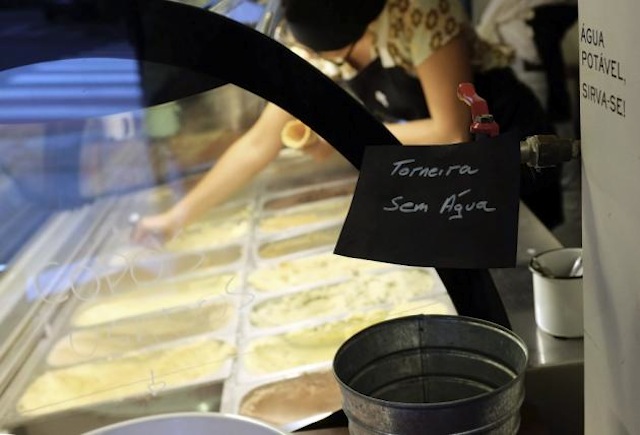
© Reuters/Nacho DoceA sign (in black) that reads "Tap without Water" is seen inside an ice-cream shop at the Pinheiros neighbourhood in Sao Paulo February 10, 2015.
Brazilians are hoarding water in their apartments, drilling homemade wells and taking other emergency measures to prepare for forced rationing that appears likely and could leave taps dry for up to five days a week because of a drought.
In São Paulo, the country's largest city with a metropolitan area of 20 million people, the main reservoir is at just 6 percent of capacity with the peak of the rainy season now past.
Other cities in Brazil's heavily populated southeast such as Rio de Janeiro face less dire shortages but could also see rationing.
Uncertainty over the drought and its consequences on jobs, public health and overall quality of life have further darkened Brazilians' mood at a time when the economy is struggling and President Dilma Rousseff's popularity is at an all-time low.
After January rains disappointed, and incentives to cut consumption fell short, São Paulo officials warned their next step could be to shut off customers' water supply for as many as five days a week - a measure that would likely last until the next rainy season starts in October, if not longer.
State officials say they have not yet decided whether or when to implement such rationing, in part because they are still hoping for heavy rains in February and March. Indeed, thunderstorms in recent days have caused lakes to rise a bit.
Still, independent projections suggest that São Paulo's main Cantareira reservoir could run out of water as soon as April without drastic cuts to consumption.
As such, the race is on to secure water while it lasts.
Large hospitals in São Paulo are installing in-house water treatment and recycling centers, among other measures, to make sure they can still carry out surgeries and other essential tasks if regular supply stops.

Comment: In addition to the drought and a looming economic collapse, Mother Nature may have other surprises in store for us. Even temporary supply disruptions caused by major storms can wipe out local grocery stores in a matter of hours. It's better to be prepared, in any case.
The writing is on the wall: Be prepared